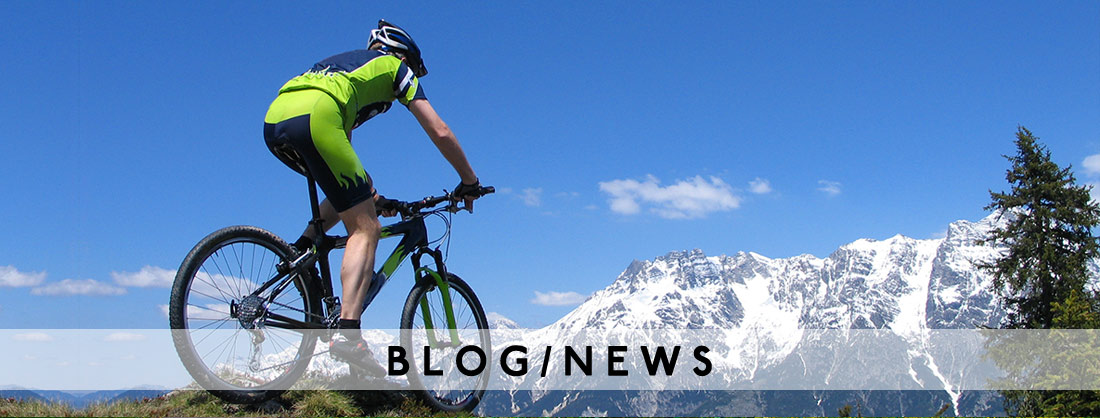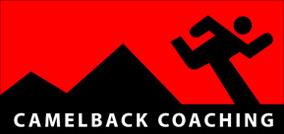The Olympic distance season is upon us, this is a great opportunity to discuss what the perfectly paced Olympic distance race should look and feel like. Olympic distance racing is the heart and soul of triathlon and learning how to race one well can improve your ability to race over all distances.
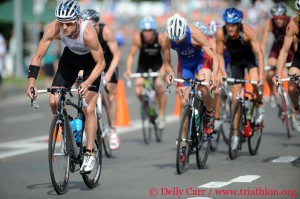 The International or Olympic distance was created in the early days of the sport (80’s) by combining the most commonly raced distances in the three individual sports – one-mile swim, 40K time trial, and the 10K run. Each of these events were also already on the Olympic program in their individual disciplines.
The International or Olympic distance was created in the early days of the sport (80’s) by combining the most commonly raced distances in the three individual sports – one-mile swim, 40K time trial, and the 10K run. Each of these events were also already on the Olympic program in their individual disciplines.
Olympic distance racing hit its U.S. peak in the 80’s with the USTS Bud Light series that had a race in most major cities and a National Championship in Hilton Head, N.C. Believe it or not, these races were much more popular than IM racing. In fact, there were only seven IM races in the world at that time. The name of the game in the 80’s was, “How fast can you go?”
When the International Triathlon Union (ITU) was formed and the focus was to bring triathlon into the Olympics, they decided that this format would be best and the distance became known as the Olympic distance. The first Olympic Distance World Championships were held in 1989 in Avignon, France. Interestingly enough, two long course stars won the event – Mark Allen and Erin Baker. Their ability to race fast over the Olympic Distance was one factor that helped them race so quickly in their long course races.
So, what exactly does a well raced Olympic Distance race look like? I’ll summarize below:
Warm up:
Complete a 15-20 min run at lev 1. Include 3-4 x 30 sec efforts at lev 4-5a. This will ensure that all of your energy systems are “turned on” prior to the race. Try and complete the warm up with about 30 min until the race start. This should leave enough time to get into your wetsuit and make it down to the water. While waiting for the start you can do arm circles to get blood moving into your arms and ready for the swim. If it is very cold water and you have to get out and wait for the start, then it is usually best not to do a swim warm up as you may freeze while waiting for your wave. If the water is reasonable, then getting in and swimming 100-400yds with some accelerations mixed in is not bad. Stronger swimmers usually like to get a swim warm up in.
Swim:
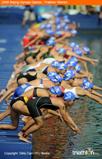
Try and start smoothly so that you avoid going anaerobic early and blowing up 400yds later. Build your effort over the first 5-10 min of the swim. Expect contact and do not fight it. Simply go with the flow if you experience contact. After about 200-400yds things will spread out a bit and you should be able to find your own space and establish a lev 3-4 effort. You should feel in control and on top of your stroke. Flailing your arms wildly at his point is not recommended. Think smooth, long stokes. Your effort should feel sub-threshold, meaning that you should feel like you are working but still in control and not on the verge of blowing up. If racing at altitude, you need to reduce the effort even further due to the lack of O2.
T1
In the last several minutes of the swim try and kick a little bit more in order to get some blood to the legs in preparation for the transition. Your mind should be thinking of your transition process flow during the last couple of minutes of the swim. Once your hand hits terra firma, stand up and start running – hard. Your transitions are one place where you can go anaerobic and sprint. Most people will jog into transition but this is a great place to make up some time. Strip the wetsuit down to your waist and run quickly to your bike. Remove the wetsuit and execute your transition process flow. Your heart rate may be lev 4-5a+ at this point due to the hard running and the blood shunting as you move from a horizontal position to a vertical position.
Bike:

Once on the bike, establish a tempo effort for the first couple of miles and let your heart rate calm down a bit. Once you start to feel that you are getting your legs back steadily increase the effort until you are working at lev 3-4. You want to race the bike at just below your LT. Too much time spent at LT or above on the bike will hurt your run. When climbing, try and maintain a high rpm in an easier gear. This is much more efficient than using too big of a gear at lower rpms. If you do that, you end up using more fast twitch muscle fibers which consume glycogen at a large rate and also cause you to accumulate more lactate. These things make running off of the bike very difficult. So, focus on maintaining an rpm above 90 when racing. When climbing, the rpms may decrease but do not allow them to drop below 90 until you are out of gear options. Once you are in your granny gear, remain seated unless rpm drops below 60. Getting out of the saddle at this point is a good way to keep making it up the hill and allows you to use your body weight to keep pushing the pedals over. On the flats and down hills, stay aero and smooth.
During the last couple of minutes of the bike, reduce your effort to lev 3 and shift into a slightly easier gear. Your mind should be fully concentrating on that run. Tell yourself that everything to this point has been about getting to the run where the real race begins.
T2
Once dismounting (preferably with a flying dismount if you are comfortable with it), run quickly to your transition spot and execute your transition. T2 should be the fastest transition of the day. Be as quick as you can, but be deliberate. Head out to the run and immediately start thinking about running with good leg turnover (90 strides/min).
Run:
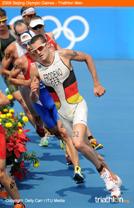
Since you have been maintaining a cadence of 90 rpms on the bike, the stride rate of 90/min should feel rather rhythmic. Establish this rhythm in your head right out of transition. You want to maintain this tempo for the rest of the run. Your effort should be lev 3 for the first 800m or so. Your heart rate may reflect this or it may be a bit elevated. Trust your perceived exertion and establish that tempo pace early. Usually this tempo pace is actually lev 4-5a, but due to the excitement of the race we usually find that lev 4-5a feels like lev 3 in that first mile. By about the mile point, everything starts to even out and your perceived effort, heart rate and pace start to look more like lev 4-5a.
If you ran that first mile well you will see the first mile marker at a lev 4-5a pace/mile with your heart rate drifting upwards and your perceived effort increasing. Now it is time to get to work. You want to hold this threshold effort for the remainder of the run. Each mile will get a bit harder with perceived effort drifting upwards with HR. However, if you are pacing yourself well the mile splits will be the same.
At mile 4, there’s a good chance you’ll run into a bit of a black hole. At this point in the race, the excitement is gone and the finish feels far away. Focus on good leg turnover. Try and complete 9 right foot strikes every 6 sec to maintain your form. If your form collapses now you will lose a lot of time over the next 2 miles. Stay on top of that tempo and listen to your internal rhythm. Soon enough you will see mile 5. Now you can get excited as you only have a little over a mile to go. Tell yourself that you have one cruise interval left. Increase your effort just a tad and ensure that you are working at lev 4-5a or a bit higher. Tell yourself that you only have “x” amount of minutes to go.
With 800m to go—do your own math—probably 3-5 min into that last mile, start increasing the effort to what feels like maximum (lev 5b-5c). Drive the arms, focus on leg turnover, and embrace the discomfort. Your final sprint should be spread out over that last mile not in the last 50yds J. If you do it right, you will cross the line at near maximal speed with nothing left in the tank. This takes a tremendous amount of concentration and mental toughness. Sometimes you get it right and the deferred pleasure can be quite nice. Other times, you might cave into to the desire to hold back a little. Not every race is perfect, but that is what we strive for.
Sometimes you eat the bear and sometimes the bear eats you. When you get it right, though it can really be satisfying knowing that you got the most out of yourself on the day.
Nutrition:
Nutrition is relatively simple in Olympic distance racing. This is one of its appeals. Simply stay hydrated before the race with a sports drink. Consider eating a gel about 20-30 min before the start. Drink 1-2 bottles of sports drink on the bike and consider eating one gel in the last 10 min of the bike. On the run, nothing – maybe a gulp of water at an aid station or two. If you are running well the race will be over before you know it. After the race enjoy the cookies, bagels, etc. After all that is why we race J. If it is particularly hot, consider some salt tablets before the race as well as a few on the bike.
The picture below is of Jarrod Shoemaker completing a “perfect race”. He is at the end of the 2007Beijing World Cup (last 10m). The first American across the line earned the first spot on the US Olympic team. He had one of the races of his life with a great swim, steady bike and blistering run. He is finishing next to Jan Frodeno the 2008 Olympic champion – not bad company. Now that is selling out!
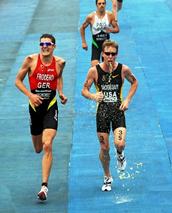
Good luck to everyone in their upcoming races!
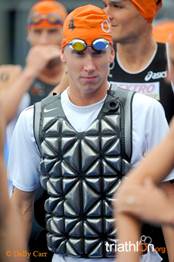 Physiologists define extreme heat as any race taking place in 80 degrees or more. Runners have long known that best performances occur in temperatures near 55 degrees. For every 10 degrees above that, race pace slows by a few percent.
Physiologists define extreme heat as any race taking place in 80 degrees or more. Runners have long known that best performances occur in temperatures near 55 degrees. For every 10 degrees above that, race pace slows by a few percent.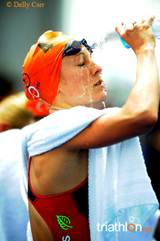
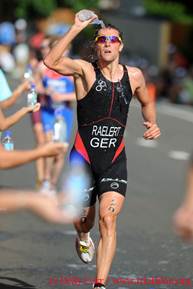 Slow down! Do not hammer at or above lactate threshold if you plan on running well. Your core temperature will elevate. It is easy do this since the evaporative cooling effect of the air on the bike makes it feel cooler than it is. If you start to feel hot on the bike then you have already accumulated too much heat – slow down. Aim at a conservative level 3-4 pace (sub threshold). The hotter it is, the slower you should go. Be sure to trust your perceived effort and speed. The heart rate will likely start climbing and be elevated all day on hot conditions.
Slow down! Do not hammer at or above lactate threshold if you plan on running well. Your core temperature will elevate. It is easy do this since the evaporative cooling effect of the air on the bike makes it feel cooler than it is. If you start to feel hot on the bike then you have already accumulated too much heat – slow down. Aim at a conservative level 3-4 pace (sub threshold). The hotter it is, the slower you should go. Be sure to trust your perceived effort and speed. The heart rate will likely start climbing and be elevated all day on hot conditions.
